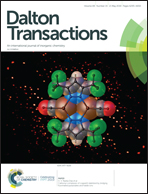Ultrahigh phase transition temperature in a metal–halide perovskite-type material containing unprecedented hydrogen bonding interactions†
Abstract
A novel organic–inorganic ABX3 perovskite-type material with specific hydrogen bonding interactions, N,N-dimethylethanolammonium trichlorocadmate ([DMEA]CdCl3), has been synthesized as a phase transition material. It is notable that the DMEA cations are arranged to form one-dimensional chains connected by hydrogen bonds at room temperature, which are very sparse in other perovskite-type compounds. The strong intermolecular interactions have made the phase transition temperature of the material reach up to 429 K, as confirmed by differential scanning calorimetry measurements, variable-temperature structural analyses, and dielectric measurements. The origin of the symmetry-breaking phase transition is associated with the motion or reorientation of the DMEA cations, accompanied by the crystal structures from orthorhombic Pnma to monoclinic P21/c with the temperature decreases. The finding of [DMEA]CdCl3 with unprecedented hydrogen bonding interactions has opened a new avenue to design novel phase transition materials with higher transition temperatures.



 Please wait while we load your content...
Please wait while we load your content...